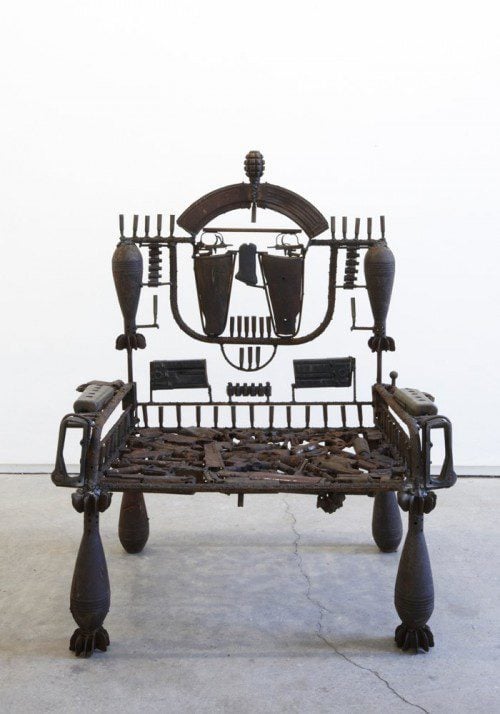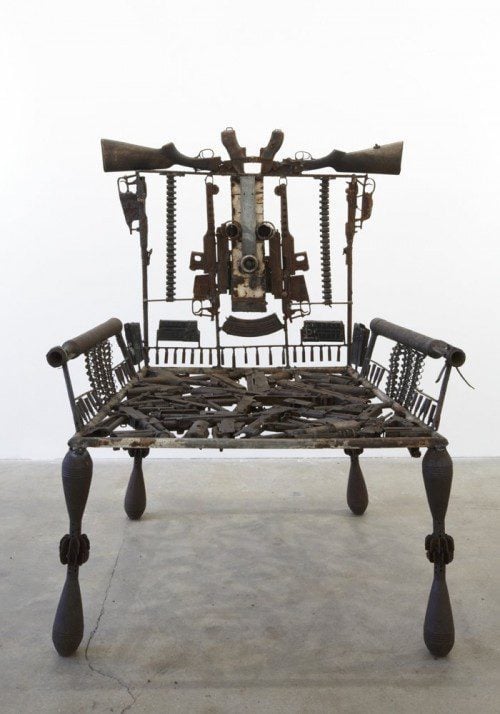LONDON (CNN) — The concept of converting “swords to plowshares” — turning from war towards constructive, peaceful endeavors — is as old as the Bible.
Today, in Mozambique’s capital, Maputo, the principle is being put into practice in a strikingly modern way, as the demobilization of weapons from two brutal wars fuels an international arts success story.
Goncalo Mabunda is an acclaimed sculptor who creates objects of beauty from instruments of death.
From his workshop in Maputo, he fashions his artworks — masks, thrones and figures — from decommissioned weapons and military equipment.
AK-47s, land mines, rocket launchers, soldiers’ boots and helmets, even sections of tank: all are warped and melded to create vivid sculptures sought by galleries and collectors around the world.
The work, says Mabunda, is “trying to represent each [person] who died with this same material.” At the same time, the creation of each piece has a very practical consequence.
“If we destroy the weapons, the same weapon’s not going to kill any more,” he said.
Even after 20 years of peace, Mozambique, a country of about 24 million people in south east Africa, still labors under the legacy of conflict.
A ten-year insurrection against the Portuguese colonial powers prior to independence in 1975 was swiftly followed by a 16-year-long civil war, leaving the country dotted with hidden troves of weapons and unexploded ordnance.
Since 1995, a group of local churches, the Christian Council of Mozambique, has been working to recover weapons from the community, exchanging surrendered guns for tools or building materials through a program called “Transforming Guns into Hoes.”
Inspired by the pacifist-spirited verse from the Book of Isaiah — “They will beat their swords into plowshares and their spears into pruning hooks” — the program has recovered more than 800,000 weapons to be destroyed, some of them through the hands of artists like Mabunda.
A full-time artist since 1997, Mabunda told CNN that his earlier works were characterized by insecurity, as he was uncertain how long his country’s fragile peace would last.
His work has since moved in new directions, yet is always informed by the experiences that have shaped his homeland, and an interest in its collective memory.
Mabunda is best known for his “thrones” — chairs made from the twisted metal of guns, symbolizing the power held by strongmen. “If you’re a soldier, you fight all day, but you have some hours you need to rest,” he said.
A recent exhibition in London, his first solo show in the British capital, also showcased a new direction: a series of tribal-inspired masks created from gun butts and bullets, drawing on African art traditions as well as referencing Mozambique’s troubled recent history.
The masks “were responded to extremely well,” by London audiences, said Jack Bell, whose gallery hosted Mabunda’s latest exhibition. “They certainly play on form from traditional African art, but have a strong connection to modern and contemporary art,” he said, citing comparisons to Pablo Picasso, Jean Dubuffet and Georges Braque.
A world away from the London art scene, Mabunda works to shape new pieces in his workshop. While it is through exhibitions in Paris, Tokyo and Dusseldorf that his pieces are finding acclaim, it is here that he hopes they will have the biggest impact.
Mabunda was first exposed to weapons through his uncle, a soldier in the ruling party’s military wing, when he was only seven years old. “I was proud about him when I was very young.”
By confronting Mozambique’s war-torn past on both a conceptual and a practical level, he hopes to play a part in ensuring future generations don’t grow up under the shadow of conflict.
The-CNN-Wire/Atlanta/+1-404-827-WIRE(9473)
™ & © 2012 Cable News Network, Inc., a Time Warner Company. All rights reserved.
 A mask from Goncalo Mabunda’s recent exhibition in London. As well as having an aesthetic value, Mabunda’s work serves a practical purpose — removing weapons from circulation and rendering them inoperable.
A mask from Goncalo Mabunda’s recent exhibition in London. As well as having an aesthetic value, Mabunda’s work serves a practical purpose — removing weapons from circulation and rendering them inoperable.
“> A mask from Goncalo Mabunda’s recent exhibition in London. As well as having an aesthetic value, Mabunda’s work serves a practical purpose — removing weapons from circulation and rendering them inoperable.
 A mask from Goncalo Mabunda’s recent exhibition in London. Mabunda, who has exhibited in Paris, Tokyo and Dusseldorf, is best known for his chairs, or “thrones,” representing power.
A mask from Goncalo Mabunda’s recent exhibition in London. Mabunda, who has exhibited in Paris, Tokyo and Dusseldorf, is best known for his chairs, or “thrones,” representing power.
“> A mask from Goncalo Mabunda’s recent exhibition in London. Mabunda, who has exhibited in Paris, Tokyo and Dusseldorf, is best known for his chairs, or “thrones,” representing power.
 A mask from Goncalo Mabunda’s recent exhibition in London. Mabunda, who was exposed to weaspons before he could read or write through an uncle who was a soldier, says he wants to do remove guns from the social landscape of his country.
A mask from Goncalo Mabunda’s recent exhibition in London. Mabunda, who was exposed to weaspons before he could read or write through an uncle who was a soldier, says he wants to do remove guns from the social landscape of his country.
“> A mask from Goncalo Mabunda’s recent exhibition in London. Mabunda, who was exposed to weaspons before he could read or write through an uncle who was a soldier, says he wants to do remove guns from the social landscape of his country.
 A mask from Goncalo Mabunda’s recent exhibition in London. The works are made from guns, bullets and other military equipment recovered from the community under a program run by the Christian Council of Mozambique.
A mask from Goncalo Mabunda’s recent exhibition in London. The works are made from guns, bullets and other military equipment recovered from the community under a program run by the Christian Council of Mozambique.
“> A mask from Goncalo Mabunda’s recent exhibition in London. The works are made from guns, bullets and other military equipment recovered from the community under a program run by the Christian Council of Mozambique.
 A mask from Goncalo Mabunda’s recent exhibition in London. Gallery owner Jack Bell says the work references traditional African art, as well as European modernist pioneers such as Pablo Picasso and Georges Braque.
A mask from Goncalo Mabunda’s recent exhibition in London. Gallery owner Jack Bell says the work references traditional African art, as well as European modernist pioneers such as Pablo Picasso and Georges Braque.
“> A mask from Goncalo Mabunda’s recent exhibition in London. Gallery owner Jack Bell says the work references traditional African art, as well as European modernist pioneers such as Pablo Picasso and Georges Braque.
 A tribal-inspired mask made from a rifle butt, bullets and other military equipment by Mozambican sculptor Goncalo Mabunda.
A tribal-inspired mask made from a rifle butt, bullets and other military equipment by Mozambican sculptor Goncalo Mabunda.
“> A tribal-inspired mask made from a rifle butt, bullets and other military equipment by Mozambican sculptor Goncalo Mabunda.
 A mask from Goncalo Mabunda’s recent exhibition in London. Gallery owner Jack Bell says the work references traditional African art, as well as European modernist pioneers such as Pablo Picasso and Georges Braque.
A mask from Goncalo Mabunda’s recent exhibition in London. Gallery owner Jack Bell says the work references traditional African art, as well as European modernist pioneers such as Pablo Picasso and Georges Braque.
“> A mask from Goncalo Mabunda’s recent exhibition in London. Gallery owner Jack Bell says the work references traditional African art, as well as European modernist pioneers such as Pablo Picasso and Georges Braque.




